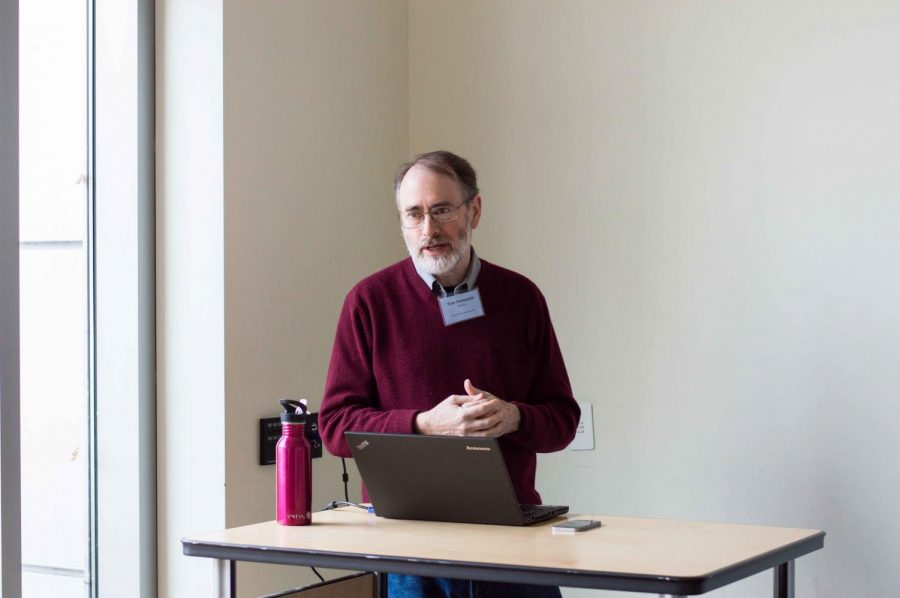Oregon State University given grant for computational sustainability
March 9, 2016
The National Science Foundation (NSF) has awarded Oregon State University a share of aw $10 million grant for the research project CompSustNet, which deals with computational sustainability. Computational sustainability, in short, is using computer science to research sustainability problems.
OSU faculty distinguished professor Tom Dietterich, Professor Alan Fern, and Professor John Selker along with researchers from Cornell University, Stanford University and eight other research institutions are a part of the project.
“The project is to provide a group of researchers with key challenges to stimulate information needs and experimental designs,” Selker said.
Dietterich, the project’s Assistant Director, explained the project explores new ideas in the field of computational sustainability. Specifically, it will consist of Microbial Fuel cells research, the project Birdcast, and research on sensor placement for the Trans-African Hydro-Meteorological Observatory (TAHMO).
Microbial fuel cells are, as defined by MIT, “devices that use bacteria as the catalysts to oxidize organic and inorganic matter and generate current.”
“Microbial fuel cells work similarly to a battery in that they generate electricity,” Professor of Biological and Ecological Engineering Hong Liu said. The fuel aspect is typically dirty waste water. The organic or inorganic waste matter in the water is filtered out and used, turning chemical energy to electrical energy, leaving clean water behind.
Microbial fuel cells can be used to power robots, sensors and more.
Birdcast is a project for tracking and studying bird migration. In 2002, Cornell University released eBird, an app and website, where birders can track bird migration in real time. Birders will be able to see approximately when and where birds will be in their area. In addition, they will have the ability to record bird sightings, connect with the eBird community and contribute to science.
Right now, the scientific focus on the Birdcast project is to track the mortality rate of birds during their seasonal migration.
TAHMO is an attempt to set up a weather prediction system for farmers in Africa. Today’s common weather sensors usually have moving parts, which tend to break, according to Dietterich, and repair costs can make affording the sensors near impossible to many farmers in Africa.
However, Dietterich said newly designed sensors with no moving parts powered by microbial fuel cells are a cost effective replacement.
“The main challenge is to optimize sensor placement,” Selker said. He thinks that the sensors should serve people by being placed in underdeveloped areas to encourage investment from outside organizations. The more than 20,000 sensors will be placed around the African continent. Data on rainfall, temperature and more will be taken and made available to farmers via cell-phone in order to decide when best to plant their crops.
Properly placed, the sensors could track conditions in U.S. national forests as well. By placing the sensors around the forest, organizations would have the ability to track wild fires as they burn.
Dietterich said that last year was a record high in spending from the fire service budget due to record high temperatures, drought and subsequently wildfires.
“We can gather data on wildfires and use the data to decide whether or not we should try to fight the fire to protect surrounding property that could be in danger, or let it burn all of the surrounding fuel to prevent fires in the near future,” Dietterich said.
According to Dietterich, using the system can lead to better, more efficient public policy making. He likes to use a pipe metaphor to explain the process.
First is the opening of the pipe, where data is collected. Using algorithms to figure out where to place the weather sensors, pairs can be placed throughout large land areas to monitor conditions and collect data, Dietterich said.
In the middle of the pipe, researchers will create model programs of the situation. Dietterich said nature is chaotic and random, so the trick here is to create chaotically random simulations. A model of a wildfire is simulated using collected data in order to determine where the fire might go, and what fire services can do to contain it.
Lastly, the end of the pipe. The programs are then used to decide on public policy. According to Dietterich, this is where policy makers will decided whether the fire should be left to burn all of the available fuel, to prevent more fires in the future, or spend the money to fight it and save property and lives that could be at risk.
The process could also be implemented on the Birdcast project, explained Dietterich. Researchers can use it to decide on public policy that determines where to place new wind turbines, as well as where to sanction off land for bird sanctuaries and at what time in the year. Rather than using sophisticated sensors, the data will be provided by the eBird community of Birders.
baro.news@oregonstate.edu


















































































![Newspaper clipping from February 25, 1970 in the Daily Barometer showing an article written by Bob Allen, past Barometer Editor. This article was written to spotlight both the student body’s lack of participation with student government at the time in conjunction with their class representatives response. [It’s important to note ASOSU was not structured identically to today’s standards, likely having a president on behalf of each class work together as one entity as opposed to one president representing all classes.]](https://dailybaro.orangemedianetwork.com/wp-content/uploads/2025/03/Screenshot-2025-03-12-1.00.42-PM-e1741811160853.png)
























